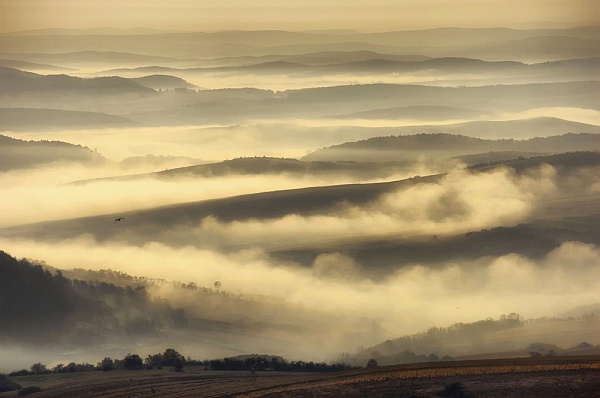
24 October 2012
“Radiation fog” sounds scary but it’s actually the kind of fog we get in Pennsylvania at this time of year. We often see it in the early morning below our hawk watch sites. (Can you see the bird in this picture?)
It forms when winds are calm overnight while the land cools. The land’s thermal radiation lowers the air temperature and condenses moisture into fog that usually evaporates in the morning.
In hilly country it’s called “valley fog” and is more pronounced because the topography traps cold air in the valleys with warm air overlaying it in a temperature inversion.
Like fog, inversions are also common in southwestern Pennsylvania in fall and winter. They can be deadly when air pollution is involved. The famous Donora Smog occurred during a five day inversion in 1948, October 27 to 31. It killed 20 people and 800 animals immediately, sickened 7,000, raised the mortality rate in Donora for at least a decade, and lowered property values (who would want to live there after that!).
Inversions still occur but our air is cleaner.
Nowadays we take for granted that our laws will protect us from air pollution. Unfortunately the laws could be weakened because companies complain it costs money to avoid killing or sickening us.
Without protection from air pollution, the fog would be scary after all.
(photo from Shutterstock)
Great blog post today, Kate 🙂
I just hope all the Republicans in Congress read it too! They could use a little education.
Speaking of bad air… Today, Thursday Oct 25, there’s an air quality alert for the Liberty-Clairton area due to fine particulate. This has a two-fold cause: weather and industry. We’re having unseasonably warm weather, up to 16 degrees above normal.
And Clairton is the home of the nation’s largest coke plant; coke-making produces lots of fine particulate.
Ditto!! Great Blog post. Teach!!
During last Thursday’s inversion (Oct 25) firefighters in the East End of Pittsburgh received 20 calls between 2:00am and 10:30am when carbon monoxide detectors went off, reporting too much CO in the air.
‘Chief Large said firefighters attributed the gas to the inversion in so many cases, because fire department equipment oddly registered a greater presence of carbon monoxide outside, as opposed to inside, “backward from what we would normally expect.”‘
Yes, the air is bad when in-home detection systems notice it.
Read more: http://www.post-gazette.com/stories/local/region/todays-weather-could-set-off-carbon-monoxide-detectors-again-659306/